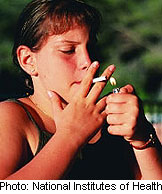- Navigating Your Midlife Crisis: Embracing New Possibilities
- City Raccoons Showing Signs of Domestication
- Mapping the Exposome: Science Broadens Focus to Environmental Disease Triggers
- One Week Less on Social Media Linked to Better Mental Health
- Your Brain Changes in Stages as You Age, Study Finds
- Some Suicide Victims Show No Typical Warning Signs, Study Finds
- ByHeart Formula Faces Lawsuits After Babies Sickened With Botulism
- Switch to Vegan Diet Could Cut Your Greenhouse Gas Emissions in Half
- Regular Bedtime Does Wonders for Blood Pressure
- Dining Alone Could Mean Worse Nutrition for Seniors
Many Teens Think ‘Light Smoking’ Is Safe, Study Finds


While the vast majority of American teens say heavy daily smoking is a major health hazard, many others mistakenly believe that “light” — or occasional — smoking isn’t harmful.
“All smoking counts,” said study lead author Stephen Amrock, a medical student in pediatrics at New York University School of Medicine in New York City. “Social smoking has a price and even the occasional cigarette truly is bad for you. Light and intermittent smokers face tremendous future health risks.”
Amrock’s research revealed “a surprising knowledge gap among teens,” he said. “We found that almost all adolescents will tell you that smoking a lot of cigarettes is very bad for your health. [But] far fewer know that smoking just a few cigarettes a day is also very harmful.”
Amrock and co-author Dr. Michael Weitzman discussed their findings in the Jan. 12 online issue of the journal Pediatrics. The research was based on a survey done by the U.S. Centers for Disease Control and Prevention.
Roughly 20 percent of adult smokers adhere to an intermittent and/or non-daily pattern of smoking. And prior estimates suggest that among child smokers, that figure rises to as high as 80 percent, the study authors said.
To better understand how teens view smoking, data was taken from the 2012 National Youth Tobacco Survey conducted by the CDC, which included nearly 25,000 public and private school students in grades six through 12.
Participants ranked the riskiness of various types of smoking behaviors such as having “a few cigarettes every day,” having “cigarettes some days but not every day,” and smoking “10 or more cigarettes every day.”
The result: 88 percent of the teens said they believed that heavy daily smoking (defined as more than five cigarettes a day) was very harmful. Only about 5 percent said they viewed heavy smoking as risk-free.
However, about two-thirds of the teens — 64 percent — said they thought light smoking (defined as less than five cigarettes a day) was equally hazardous, and about one in 10 said it posed no risk whatsoever.
Similarly, only one-third said they viewed “intermittent” smoking (defined as smoking on a non-daily basis during the prior month) as very harmful, while about one-quarter said intermittent smoking posed no harm at all.
“Our findings,” said Amrock, “suggest that public health efforts have been working, but that those efforts have likely been incomplete. Decades of anti-tobacco work have succeeded in convincing adolescents that heavy smoking patterns are dangerous, but the complete message has not been as broadly received.”
Dr. Norman Edelman, a senior medical consultant for the American Lung Association, seconded that thought.
The lung association believes continued education and stricter regulation is necessary to prevent nicotine addiction, Edelman said.
“We have to make it clear that even light smoking is dangerous. But the [association] has also long been in favor of very steep taxes on cigarettes and … banning the selling of ‘loosies’ — like two or three cigarettes — which some jurisdictions already don’t allow.”
These measures help to discourage and decrease light smoking, he said. But the emergence of e-cigarettes has created new concerns, he said.
“We think people who smoke these types of cigarettes are just as likely to go down the road towards nicotine addiction, so it’s not a simple issue,” Edelman said. “It’s something we have to continue to work at.”
More information
For more on smoking and teens, see the American Lung Association.
Source: HealthDay
Copyright © 2025 HealthDay. All rights reserved.










